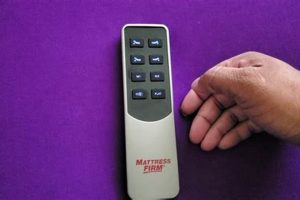These sleep surfaces provide a balance between substantial support and conforming comfort. One offers minimal sinkage and maintains spinal alignment for individuals who prefer to sleep on their back or stomach. The other allows for a bit more cushioning while still preventing excessive sagging. Both cater to a wide range of body types and sleeping preferences, providing a supportive foundation for restful sleep.
The appeal of these options lies in their versatility. The degree of support offered promotes proper posture and can alleviate pressure points, potentially reducing back pain and improving overall sleep quality. Historically, the development of different mattress firmness levels reflects an understanding of the diverse needs of sleepers, moving away from purely hard or soft options towards tailored support.
The subsequent discussion will delve into factors influencing the selection of an appropriate level of support, including body weight, sleep position, and potential health considerations. This exploration aims to equip readers with the knowledge necessary to make an informed decision when choosing a new sleep surface.
Tips for Selecting the Right Level of Support
Choosing the appropriate sleep surface requires careful consideration of individual needs and preferences. The following tips offer guidance in navigating the selection process.
Tip 1: Consider Body Weight: Individuals with higher body weights generally require a firmer surface to prevent excessive sinkage and maintain spinal alignment. Lighter individuals may find a medium firmness more comfortable, allowing for adequate contouring.
Tip 2: Evaluate Sleep Position: Back and stomach sleepers typically benefit from a firmer option to prevent spinal curvature during sleep. Side sleepers may prefer a medium firmness that allows the shoulders and hips to sink slightly, reducing pressure points.
Tip 3: Assess Spinal Alignment: When lying on the surface, observe the natural curvature of the spine. The goal is to maintain a neutral spine, avoiding excessive arching or flattening. Have someone observe from the side to provide accurate feedback.
Tip 4: Account for Partner Preferences: If sharing a bed, consider the sleeping preferences of both individuals. A compromise may be necessary, or a split-firmness mattress could be explored.
Tip 5: Research Materials and Construction: The materials used in the construction of the mattress, such as foam density and coil type, can significantly impact its overall feel and longevity. Research different material options to understand their characteristics.
Tip 6: Trial Period is Essential: Many manufacturers offer trial periods allowing customers to test the mattress at home. Taking advantage of this opportunity is crucial to ensure long-term satisfaction. Adhere to the recommended break-in period before making a final decision.
Tip 7: Consult with a Healthcare Professional: Individuals with pre-existing back pain or other health conditions should consult with a doctor or physical therapist for personalized recommendations.
Selecting a sleep surface is a significant decision impacting long-term health and well-being. By carefully considering these tips and prioritizing individual needs, one can enhance sleep quality and overall comfort.
The following sections will address common misconceptions and provide additional resources for making an informed purchase.
1. Support and Alignment
The ability of a sleep surface to maintain proper spinal alignment is paramount for preventing back pain and promoting restful sleep. A surface that is too soft allows the spine to curve unnaturally, potentially leading to muscle strain and discomfort. Conversely, one that is too firm may not conform to the body’s natural contours, creating pressure points. A balance must be achieved to ensure the spine remains in a neutral position throughout the night. Examples include individuals with scoliosis or lordosis finding relief on a sleep surface that provides targeted support to specific areas of the back, thus improving their posture during sleep. The selection directly impacts long-term spinal health.
These sleep surfaces offer varying degrees of support designed to accommodate different body types and sleeping positions. For back sleepers, adequate lumbar support is crucial for preventing the lower back from collapsing. The ability of the surface to evenly distribute weight minimizes pressure points and maintains natural alignment. A practical application includes adjusting the firmness level based on individual body weight; heavier individuals often require a firmer surface to prevent excessive sinkage, while lighter individuals may find a medium firmness provides sufficient support without sacrificing comfort. In the context of side sleepers, the surface needs to allow the shoulders and hips to sink slightly to maintain spinal alignment and prevent pressure buildup. This necessitates a level of conformability that might not be present in a very firm option.
In summary, the correlation between proper spinal alignment and choice directly influences sleep quality and musculoskeletal health. Over time, consistent support minimizes the risk of developing chronic back pain. Challenges arise when individuals have conflicting needs or preferences, requiring a careful evaluation of priorities or, potentially, exploring specialized sleep surfaces that cater to diverse needs. The understanding of this connection is fundamental for making informed decisions regarding mattress selection and optimizing sleep environment.
2. Pressure Relief
Adequate pressure relief is a critical component of sleep surface design, directly affecting comfort and overall sleep quality. The degree of firmness significantly influences its ability to alleviate pressure points, particularly in areas such as the shoulders, hips, and knees. Surfaces that are excessively rigid fail to conform to the body’s natural contours, leading to increased pressure and potential discomfort. Conversely, surfaces that lack sufficient support may allow these areas to sink too deeply, resulting in spinal misalignment and exacerbated pressure. Therefore, a balance must be achieved to ensure optimal pressure redistribution and promote restful sleep. For example, individuals with arthritis or fibromyalgia often require a sleep surface that minimizes pressure on sensitive joints to reduce pain and improve sleep.
The appropriate level of firmness, in relation to pressure relief, depends on several factors, including body weight, sleeping position, and individual sensitivity. Lighter individuals may find that a medium firm option provides sufficient cushioning to alleviate pressure without sacrificing support. Heavier individuals, however, may require a firmer option to prevent excessive sinkage, while still benefiting from
the surface’s ability to conform to the body’s shape. Sleeping position also plays a crucial role. Side sleepers, for instance, tend to experience higher pressure on their shoulders and hips, necessitating a surface that allows these areas to sink slightly, reducing strain. Back sleepers, on the other hand, require more uniform support to maintain spinal alignment and prevent pressure buildup in the lower back. A practical application involves assessing the sleep surface for areas of concentrated pressure after lying on it for a period of time. This assessment can help determine whether the surface is effectively distributing weight and minimizing pressure points.
In summary, the connection between firmness level and pressure relief is a key determinant of sleep comfort and musculoskeletal health. Achieving the optimal balance requires careful consideration of individual needs and preferences. Challenges arise when individuals have varying pressure relief requirements or when sharing a bed with a partner who has different preferences. These situations may necessitate compromises or the exploration of specialized sleep surfaces designed to address diverse needs. An understanding of these principles empowers individuals to make informed decisions about their sleep environment and optimize their overall well-being.
3. Spinal Health
Maintaining optimal spinal health is intrinsically linked to the selection of a suitable sleep surface. The capacity of the sleep surface to support the spine’s natural curvature directly impacts overall well-being and can influence the development or exacerbation of musculoskeletal issues. Choosing the appropriate firmness level is therefore a critical consideration.
- Alignment Maintenance
A primary function of a sleep surface is to maintain proper spinal alignment throughout the night. A level of firmness, neither too yielding nor excessively rigid, ensures that the spine remains in a neutral position. Inadequate support leads to spinal curvature, placing undue stress on muscles and ligaments. For example, a surface that sags excessively can cause the spine to assume a C-shaped curve, while one that is too firm may not conform to the body’s natural contours, resulting in pressure points and discomfort. The selection process aims to prevent postural distortions during sleep.
- Pressure Distribution
Even pressure distribution is crucial for minimizing strain on the spine. Concentrated pressure points can restrict blood flow and irritate nerves, contributing to pain and discomfort. Surfaces with adequate contouring conform to the body’s shape, distributing weight evenly and reducing stress on sensitive areas, such as the hips and shoulders. Individuals with pre-existing spinal conditions, such as arthritis or scoliosis, require surfaces that provide targeted support and pressure relief. Failure to address pressure distribution can exacerbate existing spinal problems.
- Muscle Relaxation
A supportive surface promotes muscle relaxation, allowing the body to recover and rejuvenate during sleep. When the spine is properly aligned, muscles are less likely to tense up in an attempt to compensate for postural imbalances. Chronic muscle tension can lead to pain, stiffness, and reduced range of motion. Selection should facilitate complete muscle relaxation, contributing to improved sleep quality and reduced musculoskeletal stress. Consider the case of individuals experiencing chronic back pain who find relief when using a mattress that provides consistent and balanced support.
These interlinked facets of spinal health highlight the significance of selecting a sleep surface that effectively supports and maintains proper alignment. The correct choice contributes not only to immediate comfort but also to the long-term health and integrity of the spine. Failure to prioritize spinal health can lead to chronic pain, reduced mobility, and a diminished quality of life. The appropriate firmness level is an investment in overall well-being.
4. Durability
The longevity of a sleep surface is a significant consideration, directly impacting value and long-term sleep quality. The construction and materials used dictate how well a sleep surface retains its original support and comfort characteristics over time. Understanding factors influencing this characteristic is crucial for making informed purchasing decisions.
- Material Composition and Density
The inherent quality of the materials significantly impacts the lifespan of a mattress. Higher density foams, for example, exhibit greater resistance to compression and degradation compared to lower density counterparts. The type of coil system employed, whether individually wrapped or interconnected, also contributes. Higher gauge steel in coils increases their resistance to deformation under consistent pressure. Choosing a mattress constructed with robust, high-quality materials is a primary determinant of long-term performance. For instance, a mattress using high-density memory foam and individually wrapped coils is likely to maintain its support and shape for a longer period compared to one made with lower-grade materials. The initial investment in quality translates to extended utility.
- Construction Techniques and Reinforcement
The methods used to assemble the mattress layers and the degree of edge support play a critical role in structural integrity. Reinforced edges prevent sagging and maintain a consistent sleeping surface across the entire mattress. Proper bonding of layers prevents shifting and bunching, which can compromise support and comfort. Features such as quilted covers and reinforced seams enhance the overall robustness of the construction. As an example, mattresses with reinforced edges and multiple layers of high-quality foam are better equipped to withstand the stresses of daily use. Attentive construction techniques contribute to a longer lifespan and sustained performance.
- Weight Distribution and Usage Patterns
The manner in which weight is distributed across the mattress and the frequency of use influence its rate of wear. Consistent concentration of weight in specific areas can lead to localized compression and degradation. Rotating the mattress periodically helps to distribute weight more evenly, prolonging its lifespan. Additionally, using a proper bed frame that provides adequate support is essential. Instances of premature mattress failure can often be traced to inadequate support or uneven weight distribution. Addressing these usage patterns is crucial for maximizing the usable life of the product.
- Warranty and Care Instructions
The manufacturer’s warranty provides an indication of their confidence in the product’s longevity. A longer warranty period often reflects a higher level of quality and durability. Adhering to the manufacturer’s care instructions, such as using a mattress protector and avoiding excessive bending or folding, can also help to extend the lifespan. Ignoring these guidelines can void the warranty and accelerate wear. Examining the warranty terms and following the recommended care practices are vital aspects of responsible mattress ownership.
These facets collectively underscore the importance of considering construction quality, material selection, and user habits when assessing a sleep surface’s ability to withstand the rigors of l
ong-term use. The long-term value is optimized when durability considerations are central to the initial selection process. For example, a higher initial investment in a durable, well-constructed option may prove more cost-effective than replacing a cheaper, less durable surface multiple times over the same period. Thorough research and careful evaluation are essential for ensuring a satisfactory and lasting sleep experience.
5. Sleep Position
Sleep position is a key determinant in selecting an appropriate sleep surface, significantly influencing spinal alignment, pressure distribution, and overall sleep quality. The relationship between sleep position and support level is critical for maximizing comfort and minimizing musculoskeletal strain.
- Side Sleeping
Side sleeping typically requires a surface that allows the shoulders and hips to sink slightly to maintain spinal alignment. An overly firm surface can create pressure points, leading to discomfort and potentially disrupting sleep. A surface on the softer end of the medium-firm spectrum, or one with targeted pressure relief zones, can better accommodate the contours of the body in this position. An example includes a side sleeper experiencing shoulder pain on a firm mattress finding relief when switching to a medium-firm option with a comfort layer that conforms to the body’s shape. The objective is to prevent spinal curvature and ensure even weight distribution.
- Back Sleeping
Back sleeping generally benefits from a surface that provides consistent support across the entire back, preventing the hips from sinking too deeply and maintaining the natural curvature of the spine. A firmer surface is often preferred to maintain proper alignment. However, an excessively rigid surface can create pressure points in the lumbar region. Therefore, a choice within the firm or medium-firm range, with a slight degree of contouring, may be optimal. A scenario involves a back sleeper experiencing lower back pain on a soft mattress finding improvement when transitioning to a firmer option that provides adequate support and prevents spinal compression.
- Stomach Sleeping
Stomach sleeping is often discouraged due to the strain it places on the neck and spine. However, if this position is unavoidable, a firmer surface is typically recommended to prevent excessive arching of the back. A softer surface can cause the midsection to sink, exaggerating spinal curvature and potentially leading to discomfort and pain. The objective is to minimize spinal extension and maintain as neutral a position as possible. The importance of choosing a supportive option is amplified for stomach sleepers. A demonstration entails a stomach sleeper experiencing neck pain on a softer option who finds partial relief switching to a firmer one. However, alternatives to stomach sleeping should be explored.
- Combination Sleeping
Combination sleepers, who alternate between different positions throughout the night, require a sleep surface that accommodates a range of support needs. A medium-firm option often provides a reasonable compromise, offering sufficient support for back and stomach sleeping while still providing adequate pressure relief for side sleeping. Alternatively, mattresses with zoned support, offering varying degrees of firmness in different areas, can be considered. An example scenario includes a combination sleeper who initially chooses a surface optimized for one position but experiences discomfort in others. A balanced option or a zoned design ensures comfort and support regardless of sleep position.
The interplay between sleep position and support level is nuanced and highly individual. While general recommendations exist, personal preference and specific needs play a crucial role. A trial period, allowing for experimentation with different surfaces, is invaluable in determining the optimal choice. Furthermore, consulting with a healthcare professional can provide personalized guidance, particularly for individuals with pre-existing spinal conditions.
6. Body Weight
Body weight exerts a significant influence on the perceived firmness and support provided by a sleep surface. An individual’s mass directly affects the degree to which the body sinks into the material. A lighter person may experience a particular surface as firm, while a heavier person may perceive the same surface as medium or even soft due to increased compression. This differential compression dictates the level of spinal alignment and pressure distribution experienced, thus impacting sleep quality. For example, an individual weighing 250 pounds will compress the layers of a mattress to a greater extent than someone weighing 150 pounds. Consequently, a mattress described as medium-firm may provide inadequate support and excessive sinkage for the heavier individual, leading to spinal misalignment and discomfort. An understanding of this relationship is essential for selecting a mattress that offers appropriate support and prevents pain or discomfort.
The practical application of this principle involves correlating weight ranges with recommended firmness levels. Manufacturers often provide guidelines specifying suitable firmness levels for different body weights. For instance, individuals weighing less than 150 pounds may find a medium-firm option suitable, while those weighing between 150 and 200 pounds may require a firmer option. Individuals exceeding 200 pounds typically benefit from a surface that offers substantial support and resistance to compression. The composition of the mattress also plays a role; mattresses with higher-density foams or robust coil systems are better equipped to withstand the compression exerted by heavier individuals. Further, when couples with significantly different body weights share a bed, choosing a mattress with strategically zoned support or considering a split-firmness design can address the disparate support needs.
In summary, body weight is a crucial parameter in mattress selection, influencing both support and comfort. Failure to account for weight can result in an unsuitable choice, leading to compromised spinal alignment, increased pressure points, and reduced sleep quality. While general guidelines exist, individual preferences and specific health conditions also factor into the equation. Challenges arise when individuals have difficulty accurately assessing their own needs or when navigating the complexities of mattress specifications. The core takeaway is that recognizing the connection between body weight and perceived firmness is fundamental for making informed decisions and optimizing sleep health.
Frequently Asked Questions
This section addresses common inquiries regarding the selection and suitability of specific sleep surfaces, providing clarity on key aspects and considerations.
Question 1: How does body weight influence selection?
Body weight directly affects the compression of mattress layers. Heavier individuals require a firmer surface to prevent excessive sinkage and maintain spinal alignment, while lighter individuals may find a less firm option provides adequate support and comfort.
Question 2: What sleep position benefits most from these options?
Both back and stomach sleepers can benefit from these options. The degree of firmness offers support to maintain spinal alignment. Side sleepers m
ay also find comfort, depending on the degree of shoulder and hip sinkage.
Question 3: How can spinal alignment be assessed when choosing a surface?
When lying on the surface, observe the natural curvature of the spine. The aim is to maintain a neutral spine, avoiding excessive arching or flattening. It can be helpful to have another person observe the spinal alignment from the side.
Question 4: What materials contribute to durability?
Higher density foams, robust coil systems (such as individually wrapped coils), and reinforced edge support contribute significantly to longevity. These materials resist compression and maintain structural integrity over time.
Question 5: How important is a trial period?
A trial period is crucial. It allows individuals to assess the suitability of the sleep surface in their own sleep environment. Adhering to the recommended break-in period before making a final decision is advisable.
Question 6: Should one consult a healthcare professional before making a purchase?
Individuals with pre-existing back pain or other health conditions should consult with a doctor or physical therapist for personalized recommendations. A healthcare professional can provide insights tailored to specific health needs.
In summary, selecting an appropriate sleep surface requires a thorough evaluation of individual needs and preferences. Body weight, sleep position, spinal alignment, and material durability are key factors to consider.
The subsequent section will explore additional resources and considerations for optimizing the sleep environment.
Summary
This discussion has detailed the attributes of a firm or medium firm mattress, emphasizing the importance of spinal alignment, pressure distribution, material durability, and the influence of body weight and sleep position on appropriate selection. An understanding of these factors is paramount in choosing a sleep surface that promotes restful sleep and minimizes musculoskeletal strain.
Prioritizing informed decision-making, individuals can enhance their well-being. A thorough evaluation of personal needs, coupled with a careful consideration of available options, serves as a strategic investment in long-term health and sleep quality.







